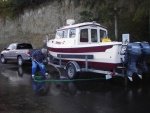Dave
No I dont use borax and prefer a sudsy detergent soap
A 1:1 ratio bleach to borax
I would use one cup of borax, one cup of regular bleach less if using concentrated (8.25%) bleach and a capful of vinegar (very low amount) in 5 gallons of hot water. Acid is optional but increases effective killing with 10-20 minutes contact time
Vinegar increases killing power of bleach ( They used more acid)
American Society for Microbiology
Adding white vinegar to diluted household bleach greatly increases the disinfecting power of the solution, making it strong enough to kill even bacterial spores. Researchers from MicroChem Lab, Inc. in Euless, Texas, report their findings today at the 2006 ASM Biodefense Research Meeting.
Sodium hypochlorite (NaOCl) in the form of laundry bleach is available in most households. The concentrate is about 5.25 to 6 percent NaOCl, and the pH value is about 12. Sodium hypochlorite is stable for many months at this high alkaline pH value.
"Laundry bleach is commonly diluted about 10 to 25-fold with tap water to about 2000 to 5000 parts per million of free available chlorine for use as an environmental surface disinfectant, without regard to the pH value of the diluted bleach. However, the pH value is very important for the antimicrobial effectiveness of bleach," says Norman Miner, a researcher on the study.
At alkaline pH values of about 8.5 or higher, more than 90 percent of the bleach is in the form of the chlorite ion (OCl-), which is relatively ineffective antimicrobially. At acidic pH values of about 6.8 or lower, more than 80 percent of the bleach is in the form of hypochlorite (HOCl). HOCl is about 80 to 200 times more antimicrobial than OCl-.
"Bleach is a much more effective antimicrobial chemical at an acidic pH value than at the alkaline Ph value at which bleach is manufactured and stored. A small amount of household vinegar is sufficient to lower the pH of bleach to an acidic range," says Miner.
Miner and his colleagues compared the ability of alkaline (pH 11) and acidified (pH 6) bleach dilutions to disinfect surfaces contaminated with dried bacterial spores, considered the most resistant to disinfectants of all microbes. The alkaline dilution was practically ineffective, killing all of the spores on only 2.5 percent of the surfaces after 20 minutes. During the same time period the acidified solution killed all of the spores on all of the surfaces.
"Diluted bleach at an alkaline pH is a relatively poor disinfectant, but acidified diluted bleach will virtually kill anything in 10 to 20 minutes," says Miner. "In the event of an emergency involving Bacillus anthracis spores contaminating such environmental surfaces as counter tops, desk and table tops, and floors, for example, virtually every household has a sporicidal sterilant available in the form of diluted, acidified bleach."
Miner recommends first diluting one cup of household bleach in one gallon of water and then adding one cup of white vinegar.



